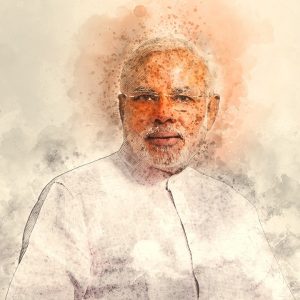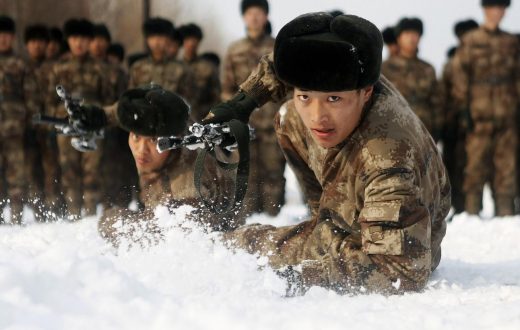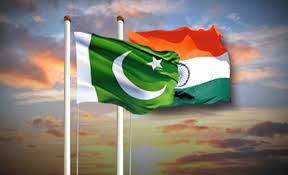After the general elections of 2019 in India, Narinder Modi has again embellished the crown of Prime minister of India on his head.

All the dreams, including the dream to make India greater and brawny power of the world, are concerned with the first prime minister of India Mr. Nehru. From the very first day the Indian premier leadership including Nehru is trying to make the foundation of the country strong. No doubt, the political parties of both Nehru & Modi are different as Nehru had a hefty CONGRESS while Modi has BJP (Bharti Janata Party). But the dreams, desires, aspirations are analogous to make their beloved country “Greater India” in the entire context e.g. political, economic, social, education, and defense & security. With the inauguration of Modi administration in 2014, India commences its voyage towards exceeding progress and decided augmentation. Under the headship of Narindra Modi, India tries to make itself economically, socially and politically more strong and get sure internal sovereignty.
Furthermore, due to sophisticated Indian premier, India gets eminent position on international level.
Now, India is ranked in the influential as well as dominant player of world affairs in general and energetic runner in Asian political marathon race with nuclear power. Under Modi, the contemporary India is quite different as compared to India during the days of Nehru.
The eras are reasonably diverse. The immense population growth, unstructured education system, peace & stability in the region, demolish terrorism from the region, publish the soft image of India in the world newspapers and play the movie cassette titled “Soft India” on TV channels are the some intentions carried by current Indian premier. Besides internal troubles, the exterior threats including terrorism and the rising China give also red signal to fresh leading management of New Delhi. According to the political pundits of India, think tanks and analysts, the rising China is the biggest external threat to Indian security. The Chinese policies and strategies e.g. Periphery strategy, Strings of Pearls, OBOR (One Belt One Road initiative) and CPEC (China Pakistan Economic Corridor) are the ubiquitous threats for India and her acquaintance and now a days, the USA is the foremost top ranked pal of India.
In modern era, every state wants more power and besides this acquisition of power, the main national interests of states are to make more affirm their existing power. The same story is associated with the world sole superpower USA. In Asian continent, the main theme of US policies and strategies are to make American power and unilateralism insistent. After the end of Cold war and disintegration of USSR (Union of Socialist Republic), the US won the Crown of world solitary superpower and introduced “MADE IN AMERICA” Liberal world Order.
After this incredible victory of the US, the popularity of the American power strokes the sky. The victory in the independence war in 16th century, W.W.I, W.W.II and in Cold War were proved that the US is exceptional power. The US wants its exceptionalism. As a specific term “American Exceptionalism” was first referenced by author Alexis de Toqueville in Democracy in America, a book published in the 1830s. Throughout the latter half of the 19th century, when America began to build its empire, the idea that the US was special and blessed by God reigned supreme. In addition, America’s victories over Japan and Germany revitalized the belief that the US is unique and a new expression for American exceptionalism was born. On January 9, 1961, John F. Kennedy said, “Today, the eyes of the world of all people are truly upon usand our government, in every branch, at every level, national, state and local, must be as a city upon a hill.” Kennedy was promoting the idea that not only is the US economically and socially unique, but its political system is an example of a model government. After the Cold War, the American model became the new norm; American exceptionalism became a much more popular concept.
In 1996, Bill Clinton said that “America remains the indispensable nation” and that “there are times when America and only America, can make a difference between war and peace, between freedom and repression.” This American exceptionalism term further materialized one more idea of “American Paternalism”. American paternalism refers to America’s belief that other states in the international system need the US and the American desire to interfere in the affairs of other states for the good of that state, the international system, or both. In many ways, American paternalism is derived from American pride and linked to American exceptionalism. As the hegemonic power, the US has a tendency to treat its relations with other countries as parent-Child relationships, which is one of the reasons the US feels comfortable violating state sovereignty and interfering in the affairs of other states for moral reasons such as human rights violations, civil war, etc. The United States relationship with present international system is different from the relationships that other states have with the current system. In the aftermath of W.W.II, the world was in shambles and the US set out to construct a new international system and a new world order, one which it hoped would bring peace, development and prosperity. The US was challenged by the USSR, and because the both were interested in building inconsistent kinds of worlds. After the collapse of USSR and the end of Cold war in 1991, American vision for the world became a reality. With the establishment of the new American-led liberal world order came the emergence of American paternalism as it is now. American paternalism is also directly connected to the American desire to preserve its leadership in Asia. The US believes that not only is American leadership in Asia in the best interests of the US, but it is also in the best interests of Asia and according to American leadership, the US sees itself as a parent for the international system and Asian region. American hegemonism is the byproduct of American exceptionalism and paternalism. According to the political specialists, the US is indeed a global hegemon. American hegemonism is the desire to promote and preserve this hegemonic status as well as protect its power at all costs, makes the US a threat to revisionist challengers including Russia, North Korea and rising China. With the beginning of 21st century, the world structure has reshaped from uni-polar to multipolar and with the passage of time the friendships, relationships, rivalries and national interests of the states have been re-examined. The living example of above sentence is the romance between India and the US with the turn of 21st century. After the 50 years of estrange relations, the two democracies India and the US decide to renovate their relations in potent strategic nexus. Now, India is the top listed country in the documents of Washington as steadfast, strong and committed ally. On the contrary, Pakistan who was the active member of the US made security alliance blocs like SEATO, CENTO and fought proxy war against USSR during Soviet invasion of Afghanistan in late 1970s, is now, very far from the US kindness and considerations. The rising China, developed Japan, Russian juxtaposition with Asian states, Chinese OBOR & CPEC projects, emergence of SCO, the economic & natural resources supremacy of Asian region, the Indian Ocean significance, natural resources of central Asia and Chinese expansion and sea lanes of communication (SLOC) from straits of Harmuz to Persian Gulf and Chinese active appearance in (SLOC) give red signal to the US hegemonism in Asian region. The US takes China as a revisionist state as like as the USSR after the World War II. The political pundits argue that this is second Cold War as well as emergence of bipolarity between the US and China and the present American leadership will repeat its history by making alliance in Asian continent same like during the Cold war era against USSR and the US will try its best to change the bipolar to unipolar system another time because the US takes rising China as USSR part II in 21th century.
The US is taking alliance making theory and give heavy aid to Asian countries, do agreements, sign nuclear deals like India, build strategic partnership to counter its present competitors and rising revisionists states and try its best to preserve its ideology of exceptionalism, paternalism and hegemony in Asian region. Therefore the Trump’s slogan during his election campaign was “Make America great again”. From Nixon to Obama and now Trump, the foremost objective of the US is to maintain its hegemony in Asia and protect its national interests. For the acquisition of national interests, once again America is making ally in the region and India is the most favorite state in Asia generally and in South Asia specifically. Additionally, the permanent seat in United Nations Security Council (UNSC), economically development, brawny defense, advancement in arms, soft image at international level, threat of rising China and the dream of “Greater India” are crucial factors behind the Indian juxtaposition in the arms of the US and both states ready to start polite lovely strategic romance with the identification of “strategic partnership”. Apart from the Indian non-alignment policy, Nehru slogan of Asia for Asians, India-USSR proximity in Cold War, the paradoxical role of the US during India-Pakistan wars, ideological differences, diverse national goals and estrange relations during the Cold war, Now, after the end of the Cold War and especially with the awake of 21st century the US and India renovate their relations from estrangement to strong partnership. According to the Indian Diaspora and leadership, the rising China expansionism in Asia, Chinese involvement in Indian Ocean and OBOR project, vigorous course of actions in seaports in Asia, CPEC project in Pakistan, Chinese growth towards South East Asia, Africa, Middle East, Central Asia & Latin America regions and the energetic escalation of SCO in Asia are the threats to Indian security in contemporary era. The beginning of strategic partnership with the US is the foremost & only solution for India to overcome this rising China threat. In addition, India has very inadequate options to counter the rising power of China. First, if India adopt the non-alignment policy, this is not suitable for this modern era.
Today, one state is dependent on another state. Second, if India adopts internal balancing in the context of Balance of power to balance China, India is not internally powerful, stable and has not numerous resources. The last and more suitable option is to do bargain with the US against their common threat (China). There are several reasons behind this Indian bargaining with the US. First, the US is superpower. Second, the US has its own hidden interests in it and takes China as emerging threat to the US hegemony in Asia. Third, India is emerging power of Asia and associated with Indian Ocean and SLOC. Forth, the US is scared that if Asian powers e.g. India, Russia, China Japan, Vietnam, Korea, Pakistan and Australia get united in coming future then American power in Asia will be ended. So, in closing remarks, India and the US have vivid future because both democracies are indispensable for each other in modern geopolitics. Apart from most fifty years estrange relations during Cold War, divergences of ideas, clash of interests, diverse in some values but the rising power of China is the crucial factor behind the foundation of strong strategic nexus between India and the US. The political analysts argue that It is again Cold War which will be between the US and China. And America is trying by leaps and bounds to win this Cold War again by any means because the US doesn’t want to lose its excpetionalism status. On the other side, India also wants to stop the rising power of China to embellish the crown of Asian power on its own head. That’s why, apart from Past divergences of interests, currently, Modi visit to US with titled “Howday-2019” and reciprocally Trump Visit to India labeled “Namste Trump”, both of the Leaders of democratic states Modi and Trump are following the words “Old wines in the new glasses” and they have their own interests which are associated with each other and both are hopeful to their bright future trade, economic, defense and strategic relations.








